#lunar eclipse in India
Explore tagged Tumblr posts
Text

Wasn't that moon last night just delightful? ♥
Demoiselle Crane (Grus virgo) AKA koonj or kurjan
Eurasia and Central Asia, from the Black Sea to Mongolia, North Africa to India
Status: Least Concern; protected by CITES
---
With the Virgo lunar eclipse last night, I decided to draw a Grus virgo. Known as koonj or kurjan in India, they are popular in the literature and the arts.
By the way, a little announcement—I have a bluesky, feel free to follow there!
#crane#bird#koonj#kurjan#bird art#birdlr#virgo#lunar eclipse#asia#middle east#turkiye#egypt#sudan#russia#iran#kazakhstan#afghanistan#india#china#mongolia#bangladesh#armenia#azerbaijan#georgia#turkmenistan
54 notes
·
View notes
Text
"Rāhu: El Demonio Celestial y su Papel en los Eclipses de la Mitología Hindú"
#(mitología hindú)#Astrología Védica#Cosmología Hindú#cultura india#Demonios Celestiales#Eclipses Lunares#Eclipses Solares#Karma y Espiritualidad#Rituales Hindúes#Rāhu#Samudra Manthan#Simbolismo del Eclipse.
0 notes
Text
Lunar Eclipse In September 2024: Things To Do Before, During, And After Chandra Grahan | Culture News
September’s full moon, a supermoon, will be partially eclipsed by Earth. This celestial event, visible on September 18, will begin at 7:42 AM IST and end at 8:45 AM IST in India. The eclipse, visible across multiple continents, will have Saturn accompanying the spectacle. Though only 8% of the moon will be covered, it holds cultural significance, especially in India, where certain rituals and…
#eclipse cultural significance#eclipse in India#eclipse precautions#eclipse-eating#Lunar Eclipse 2024#lunar eclipse live#lunar eclipse rituals#partial lunar eclipse#September lunar eclipse#supermoon lunar eclipse#what to do during lunar eclipse
0 notes
Text
Chandra Grahan 2024: चंद्र ग्रहण पर भूलकर भी न करें ये काम, नहीं तो पड़ सकते हैं मुसीबत मेंChandra Grahan 2024: हिंदी पंचांग के अनुसार चंद्र ग्रहण फाल्गुन मास के शुक्ल पक्ष की पूर्णिमा तिथि यानी 25 मार्च 2024 सोमवार को लगेगा. यह चंद्र ग्रहण सुबह 10:23 बजे शुरू होगा और दोपहर 03:02 बजे तक रहेगा
#How many total eclipses are there in 2024#is there any eclipse in 2024 in india#where is the path of solar eclipse 2024#what does the eclipse look like#lunar eclipse 2024#how many eclipses will occur in india in 2024#astrology today#astrology today in hindi#Astrology News in Hindi#Astrology Hindi News
0 notes
Text
Lunar Eclipse 2024: A Celestial Phenomenon Unfolding
Experience the awe-inspiring spectacle of the Lunar Eclipse 2024 as the moon gracefully transitions through Earth's shadow. Discover the precise date and time for this celestial event in India, marking a moment of cosmic alignment you won't want to miss.

#lunar eclipse 2024#lunar eclipse 2024 in india date and time#lunar eclipse 2024 in india#Lunar Eclipse 2024: Date#Time#Lunar Eclipse impact on zodiac sign
1 note
·
View note
Text
Lunar Eclipse 2023 to Enchant Star Gazers on October 28-29th
The Lunar Eclipse 2023 is a Celestial Event that will Captivate Astronomy Enthusiasts in India. Stargazers and astronomy admirers are in for a mesmerising treat later this week as a partial lunar eclipse is set to adorn the night skies on October 28-29. Following the annular solar eclipse earlier this month, the upcoming lunar spectacle marks the second significant celestial event of the…

View On WordPress
0 notes
Text
Types of Astrology
Astrology isn’t a one-size-fits-all system. Across cultures and eras, different branches of astrology have evolved, each with its own techniques, philosophies, and interpretations. While they all share the belief that celestial patterns mirror life on Earth, the way they read those patterns can vary significantly.

Here are some of the most well-known types of astrology:
🌞 1. Western Astrology
Also known as Tropical Astrology, this is the most common form in the West.
Zodiac system: 12 signs based on the seasons, not the constellations.
Focus: Natal charts (birth charts), transits, progressions, and synastry (relationship charts).
Philosophy: Rooted in Hellenistic astrology, blended with modern psychological and spiritual perspectives.
Tools: Houses, planets, aspects, and angles.
✨ Common Use: Horoscopes, self-exploration, predictive insights.
🌙 2. Vedic Astrology
A sacred system from India, thousands of years old.
Zodiac system: Sidereal zodiac, based on the actual constellations.
Focus: Dharma (life path), karma, and spiritual evolution.
Tools: Dasha periods (timing system), Nakshatras (lunar mansions), planetary yogas, and divisional charts.
Philosophy: Deeply connected to karma and dharma, with predictive precision.
🔱 Common Use: Life purpose, marriage timing, spiritual insight, remedy prescriptions (e.g., mantras, gemstones).
🐉 3. Chinese Astrology
A system that integrates cosmology, philosophy, and medicine.
Zodiac system: 12-year cycle with animal signs and elements (Wood, Fire, Earth, Metal, Water).
Focus: The Four Pillars of Destiny (BaZi), used to determine fate, compatibility, and timing.
Philosophy: Interplay of Yin-Yang and the Five Elements.
🐲 Common Use: Fortune-telling, compatibility, life path guidance.
🔮 4. Hellenistic Astrology
The root of Western astrology, practiced around 2nd century BCE to 6th century CE.
Zodiac system: Tropical zodiac with whole sign houses.
Focus: Fate, life themes, and planetary rulerships.
Tools: Lots (e.g., Lot of Fortune), time-lord systems like Zodiacal Releasing.
Philosophy: More deterministic than modern Western astrology.
📜 Common Use: Ancient techniques revived by astrologers seeking original methods
🌌 5. Evolutionary Astrology
A modern spiritual approach that explores the soul's journey across lifetimes.
Focus: Past-life themes, karma, and soul evolution.
Tools: Pluto, lunar nodes, and deep natal chart analysis.
Philosophy: Each chart reflects not just who you are — but who you are becoming.
🦋 Common Use: Spiritual growth, soul-purpose readings.
🧬 6. Medical Astrology
(Iatromathematics)
An ancient system that correlates zodiac signs and planets with parts of the body and health patterns.
Focus: Diagnosing health imbalances through the chart.
Tools: Planetary rulerships of organs, humors, and timing.
Philosophy: Illness is linked to cosmic imbalance.
⚕️ Common Use: Herbal recommendations, holistic healing, timing of surgeries.
🏛 7. Mundane Astrology
The astrology of world events.
Focus: Political shifts, natural disasters, economic trends.
Tools: Ingress charts (e.g., when planets enter signs), national charts, eclipses.
Philosophy: Nations and leaders have charts too.
🌍 Common Use: Forecasting elections, market trends, world events.

✨ Other Forms Worth Exploring:
Electional Astrology – Choosing the best time to start something important (like a wedding or business).
Horary Astrology – Answering specific yes/no questions by casting a chart for the moment the question is asked.
Locational Astrology (Astrocartography) – Finding the best places for love, work, or personal growth based on planetary lines on the map.
Each type of astrology offers a different lens on the same sky. Whether you resonate with Western charts, Vedic timing systems, or Chinese destiny analysis, the stars speak many languages — and you can choose the one that speaks to your soul.
14 notes
·
View notes
Text
☋☋ ☋ मघा Magha Nakshatra मघा ☋ ☋☋
Past lives, ominous, traveling inward

Hughes Merle's Mary Magdalene in the Cave, 1868. The reptilian arms are not part of the original painting.
The Basics Ruling planet: Ketu Ruling deity: Pitris Yoni: Male rat Symbol: Royal throne
Rahu and Ketu We can't talk about Ketu without talking about Rahu as well. Rahu and Ketu are referred to as the lunar nodes in astrology. They aren't physical objects in space like Jupiter or Saturn. They are calculated points. However, for ease of communication, Rahu and Ketu are often referred to as planets anyways.
The lunar nodes are determined by the orbits of the sun and the moon. The intersections of the orbits of the sun and moon as apparent from Earth tell us the position of the nodes at a given time. It takes about 18 months for the nodes to journey through a single zodiac sign and about two decades for them to cycle through all twelve.

Image from Wikipedia.
Since the nodes are located where the sun and moon overlap as seen from Earth, they are associated with eclipses. Rahu (the north, or ascending node) swallows the sun during a solar eclipse and Ketu (the south, or descending node) swallows the moon during a lunar eclipse. We can further assume that the nodes are always exactly 180° apart, or opposite to, one another. If the north node is in Sagittarius, for example, the south node will always be in Gemini.
The nodes in astrology deal with karmic destiny. The nature of your south node placement shows who you were in a past life, what you have previously mastered and now know in your bones to be true. Your north node placement shows what you are working towards in this life, what you strive to accomplish, the lessons you are here to master.
Rahu and Ketu In Mythology According to Vedic mythology, Rahu and Ketu started out as one being, a demonic serpent called a rakshasa. They were separated into two beings as punishment. During a ceremony to honor the planets, Lord Visnu churned up the oceans to create a divine nectar for them to drink and become immortal. When the planets (or deities) lined up to drink, the demon snuck under Visnu's nose to drink some of the nectar for himself. Rahu/Ketu had already ingested the immortal drink before they were caught in the act - becoming accidentally undying. Furious, Visnu beheaded the demon but at that point it was too late. Rahu (the demon's head) and Ketu (the body) become two entities and were cast to opposite ends of the sky.

A depiction of a rakshasa (demon) done in Yakshagana, a traditional style of theater prominent in southern India. Image from Wikipedia.
Rahu, being the head, is arguably more responsible for the separation of the demon into two parts. As the head, Rahu is consumptive by nature. This is why one's natal Rahu placement indicates what they are after in this life. The devouring head symbolizes our insatiable desire to obtain more and become more.
Rahu's willingness to ignore boundaries to obtain the immortal nectar is telling - he has no regard for authority. He is not much of a leader himself, more so interested in mocking those holding positions of power. In this way Rahu is hypocritical because he attacks the character and methodologies of those in power yet he himself demonstrates childishness and irreverence. When he is rendered a head without a body, he is left an eternal troublemaker.
When separated from his head, bodily Ketu is doomed to forever long for his other half - reminiscent of the past being the past, something we can never go back to and simultaneously can't shake the memory of. We master our Rahu and Ketu by connecting our heads with our bodies - that is, by balancing past with future, applying ancient knowledge stored in the body to achieve future-facing objectives the head seeks to fulfill.
"Ketu's permanent longing for wholeness is a consequence of Rahu's excited refusal to respect conventional boundaries. As a result of Rahu's wildness, Ketu the Dragon-Tail Cauda Draconis is forced to gaze with eternally unsatisfied longing at His dear severed partner Rahu the Dragon-Head Caput Draconis." - Barbara Pijan Lama, Vedic astrologer based in Portland, Oregon

A makeup look done by smeyuka on Instagram. Note the grey/smokey tone of the face and red emphasis added to the eyes.
In Phaladeepika, a classical Sanskrit text on Vedic astrology, Ketu is described like this:
"Ketu is fiercly red-eyed, is venom-tongued (speaking venomously), and without a body or disembodied, he is violent (using weapons, wants to scare), and ignoble (low, fallen, no social contribution, uncultured, wild, intense), his complexion is smokey (ominous), he is a constant smoke drinker (using opium or marijuana), his body is covered in scars (not cooperative), not fatty (emaciated, thin, angular), and cruel (unforgiving)."**
** what is in paranthases are notes on different ways the text can be translated. Watch Vic Dicara's videos on Rahu and Ketu.
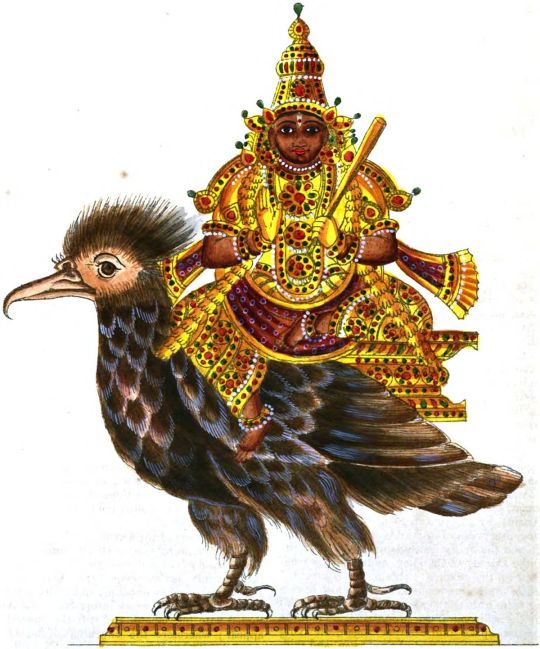
Artistic rendition of Ketu/Kathoo in E.A. Rodrigues's The Complete Hindoo Pantheon. Image taken from Wikipedia.
Some people think that what we experience as eclipses are actually Rahu and Ketu taking revenge for their separation. Eclipses are times of sudden change - when the sun is obscured by the moon or vice versa, the atmosphere on Earth is very different. Having witnessed the total lunar eclipse of 2017, I remember things turning a grey/yellow/brown hue, and the air taking on a kind of hazy quality (but I believe this was due to wildfires). If you have ever seen the movie Enemy with Jake Gyllenhaal, it looked like that.

Still from Enemy (2013)
Here is a description of a solar eclipse by Dr. Rick Feinberg, astronomer and science communicator (now retired):
"Measurements made at recent total eclipses put the illuminance at totality around 5 lux, comparable to civil twilight. The sky is still some shade of silvery, purply blue. In contrast, the black sky on a night of full Moon is 10 times darker still, less than 0.5 lux. Yes, bright planets –– especially Venus and Jupiter –– are obvious in twilight, but stars? I don’t like to waste valuable time during totality looking for stars; the only time I saw one was on August 21, 2017, when 1st-magnitude Regulus glimmered just to the left of the totally eclipsed Sun.
It certainly feels like it gets as dark as night during the final minute before totality, but that’s just because your eyes haven’t had time to adjust. The changes in illumination at the beginning and end of totality happen much faster and more dramatically than at dusk and dawn, respectively."

Image of the 2019 solar eclipse above the European Southern Observatory in Chile, taken by Mahdi Zamani.
Non-dualism and the Ouroboros The nodes are inseparable opposites, both two and one - like how the past and future becoming one in the present. In this way they demonstrate the concept of non-duality. Non-dualism is a philosophical concept observed in many spiritual and religious traditions, particularly ones that originated in the East such as Buddhism, Hinduism, and Taoism. The non-dual perspective holds that there is no fundamental separation - between objects, energy, people... it's all one.
“All things are permeated with God, just as all things are permeated with air.” – Hildegard of Bingen
Ketu's rulership over Magha suggests that people with heavy influence from this nakshatra in their birthchart are deeply spiritual and/or philosophical. If you think about Rahu and Ketu as being an axis - that is, talking about the same topics but having opposite opinions on them - Rahu expands outwards, forever seeking to consume and grow materially. Ketu expands internally. The expansion of Ketu looks like material poverty from the outside, but Ketu is not interested in earthly objectives. Rahu wants to grasp and Ketu wants to release. By releasing attachment to the physical, Ketu finds bliss.
Rahu's knowing is of the head. It is entirely cerebral. Ketu's knowing is bodily. That is, it is completely intuitive and feeling/sensory-based. In the world we live in, computational and logical thinking is (for better or worse) king. For this reason, if you have prominent Magha placements, I wouldn't be surprised if you feel like you either 1) don't belong in this world or 2) have been here before, perhaps many times over. Ketu, symbolizing past lives and knowledge gained from them, wanders the earth, aimless, forever drifting. He finds nothing on earth to be of substance.
While Ketu-heavy or Magha-heavy people can possess deep inner knowing that endows them with a certain type of respect, this same trait can be the source of an overly apathetic attitude when taken to an extreme. Detachment is all well and good, but unless you're truly the type to pursue a monastic or nomadic path, it's necessary to keep your feet on the ground at least a little bit to live in a well-rounded way. Ketu people are faced with a challenge to ground their intuitive knowledge and bring what they find on their travels inward out to the world around them.
One symbol that is steeped in unity and oneness is the ouroboros. Depicting a serpent or dragon devouring it's own tail, the ouroboros has appeared in ancient Egypt, Mexico, India, as well as Hermetic and Alchemical texts. The serpent chases its continually regenerating tail in an eternal circle, just as Rahu and Ketu are condemned to chase one another from opposite ends of the sky forever.

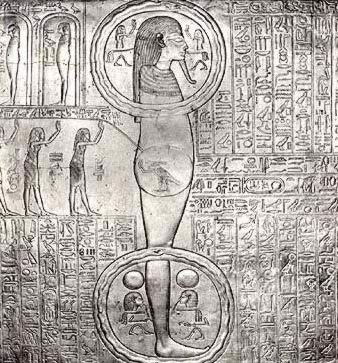
Two ouroboros symbols shown encircling a figure in An Enigmatic Book of the Underworld, funerary text and shrine discovered in King Tutankhamun's tomb. The figure has been speculated to be the mummified form of King Tut himself, while some think it is the unification of Ra and Osiris.
An Enigmatic Book of the Underworld is regarded as the place of the first appearance of the ouroboros, dating it to at least 14th century BCE. It is thought that the book illustrates the replenishing of the solar disc - the ancient Egyptians believed that the sun would use up all of it's heat and energy during the day and had to 'recharge' at night. At night, the Sun was said to pass through the same region of death where the gods were believed to reside. Their souls would follow the Sun as he cycled above and below the horizon while their bodies remained in the underworld. Time was seen as cyclical repetitions rather than a linear unfolding. The ancient Egyptian's understanding of time was based on their observations of recurring natural events like the Sun's daily journey across the sky and the annual flooding of the Nile.

An illustration of the ouroboros in an alchemical text from around 400AD.
The Alchemists believed that all physical materials on Earth originated from the same original source material and could be differentiated by their varying levels of purity. Gold was held as the most pure and 'perfect' form of matter, which is why the Alchemists sought to create it using lower quality metals such as lead - a process called chrysopoeia. The desire to create gold from crude materials that is central to Alchemy is largely metaphorical. The broader goal of the Alchemists was to evolve the human soul through deepening the understanding of one's self. The ultimate objective of alchemy was to transform personally into someone 'greater' than you were before. More knowledgeable, powerful, physically healthy or beautiful...
The Pitris The deities ruling Magha are the Pitris, spirits of the paternal ancestors of humanity - the word 'pitris' is Sanskrit for "fathers."
The word Magha can mean gift or it can mean power. As it relates to Magha nakshatra, it means gifted power - that is, inherited power. Each nakshatra has it's own associated sutra, which are kind of like condensed teachings. The translated sutra for Magha is "The forefather's gift of power needs demoralization, to ruin."
Vic Dicara explains the lesson of Magha nakshatra as illustrated in it's sutra - how to be victorious without getting wounded. The sutra for Magha is saying that the way to defeat your enemies is to prevent the battle from happening in the first place. And how do you do that? By bullying them, basically. Magha natives have the power of the forefathers (Pitris) behind them, which they brandish and threaten their potential opponents with. Before a single punch has been thrown Magha puffs out his chest, letting his opponent know that he has friends on the other side backing him up - think Dr. Facilier from the Princess and the Frog.

Magha's Yoni: the Male Rat The word "yoni" in Sanskrit refers to the vagina. The word can be used to refer literally to female genitalia, but it also has a deeper meaning relating to source material - the empty 'womb' out of which the universe materialized.
Each nakshatra has a corresponding yoni assigned to it. The yonis of the nakshatras describe their primal and sexual nature - how they behave when backed into a corner and the different ways they behave in the bedroom. In the vedic astrological system, the yonis are depicted as different types of animals - appropriate, considering the aspects of the human personality they attempt to describe and categorize.
Magha's yoni animal is a rat. Rats are inquisitive, playful and sociable by nature. They are intelligent and, as pets, trainable. They are hygienic, keeping themselves clean by grooming their tails, fur, and faces. They also do everything quickly - I've never seen a rat move in a leisurely way.

Rats are venerated at the Karni Mata temple in Deshnoke, India. Large saucers of milk are left out to keep them fed. The temple is a monument honoring the coexistence of life in every form - which is why rats are treated reverence here rather than seen as pests. Image by Paolo Bampani.
The rat signifying the primal nature of this nakshatra suggests a few things. We can easily surmise that Magha people are curious, likely quick-witted due to an above-average intelligence, and energetic. We can also guess that Magha people are adaptable - think about the poor conditions rats are able to survive in. An additional quality of rats which I think relates to Magha is their use of their whiskers to both balance themselves and maneuver around objects in their environment - they don't have the best eyesight and rely heavily on the sensitivity of their wire-y mustaches. This hearkens to Magha's bodily, ketuvian intelligence.
At first, the personality of the light-footed and friendly rat seems to clash with the ancient wisdom Magha has. When I think of someone in touch with their forefathers and past lives, I think of someone who moves slowly (literally and metaphorically), approaching and completing all tasks with patience, precision, and caution. The good-natured and hyperactive qualities of the rat combined with Magha's connection to protective (paternal) ancestors, dispersing and wandering ways of Ketu, and transforming power of the eclipse paints a particular personality profile. This is a person who has their head in the clouds and could rip you to shreds - if you provoke them first.
The Symbol of the Royal Throne Magha is considered to be an auspicious nakshatra - that is, it brings positive things to whatever planet is placed here. The rulership of the Pitris over Magha cements their innate power. It is one thing to be a powerful person because of the things you have accomplished, but when someone is powerful because of their ancestors has royalty in their blood. It can never, ever be taken from them because it is simply who they are.
Magha spans 0°00' to 13°20' Leo. Leo is the most regal and royal of all twelve zodiac signs. The most common gripe people have with Leo's is their pride and self-centered attitude. The thing is is that Leo is ruled by the Sun - the literal center of our solar system. Resenting a Leo for shining is like disliking the Sun for burning. Of course, egotism has the potential to run rampant if a Leo person has not matured very much, which is the shadow side of this sign. Oftentimes, though, you will find that the warm, glowing self-sureness of Leo's triggers the insecurities in those around them, causing them to lash out.

The Iron Throne from Game of Thrones.
The symbolism of the throne for Magha should come as no surprise. Those who sit and have sat in thrones throughout history were usually born into that role as opposed to being appointed - bringing us back to the ancestral power brought on by Magha's connection to the Pitris.
Song for Magha: You Don't Mess Around with Jim by Jim Croce And they say... You don't tug on Superman's cape You don't spit into the wind You don't pull the mask off that old Lone Ranger And you don't mess around with Jim
This song talks about a local legend who's reputation precedes him. It is known so well that you don't cross him that doing so would be as obviously foolish as spitting into the wind. While Jim, the menacing figure the song centers around, is described as being big and dumb - traits that aren't as applicable to Magha - his reputation as someone you don't want to mess with fits perfectly with the power of this nakshatra. Jim, just like Magha, has won the fight before it started because you're probably too intimidated to approach him in the first place. Maybe Jim had the Pitris backing him up, too.
-------
Check out Vic Dicara and Claire Nakti on YouTube - both influential figures in the vedic astrological community.
92 notes
·
View notes
Text




Happy Holidays, @allpatchedart !
Your Fort-Lune Holidays request really inspired me so I went a bit overboard with the world building of my illustrations.
Image 1 is a Day of the Dead/Lunar eclipse celebration
Image 2 is a more classic Village or Harvest festival.
Image 3 is inspired by the Holi Hindu festival.
Image 4 is a Carnaval/Mardi Gras/Halloween festival.
Hope you’ll like it!
(If you want the details of each holidays and some general lore, I’ll put it underneath the cut.)
First of all, I had to decide on the designs of the characters so I based them on the 3 characters you see on Fort-Lune as well as Sagitta clothing (since they are originally from there), which I find to be inspired by Tibet clothing. I also added a few modern or futuristic ones.
I also thought of the architecture there. We only see the big metal tower int the game so I was thinking that the building on the Moon would be very utilitarian and bland : simple square geometric shapes, variations go gray concrete and metals. Only the fancier buildings could afford more colors since most of those pigments would have to be taken from Luxendark.
1 - While the Moon Dwellers are not Orthodox Crystalists, they still worship the Crystals in some ways. They also greatly the connections with their cousins on Luxendark. That’s why every year, on the Day of the Dead, they burn great bonfires and and illuminate small crystals so that the soul of the dead can return to their native land and continue the cycle of live created by the Crystals. That connection is even greater during Lunar eclipses, or Blood Moons, an event also celebrated in Luxendark.
(I also put a Magnolia mourning her loved ones)
2 - Every Nation needs a Harvest festival. Usually more of a big village festival, the Moon Dwellers is it to connect to one another and to be grateful to the food they receive. Ressources on the Moon are scarce and they often have to send covert missions on Luxendark to find more of them.
3 - The Holi festival is often celebrated in India by throwing colored powder at each other. It has both religious connotations and a celebration of Spring. On the Moon, there are no seasons.
As I said before, Fort-Lune seriously lacks colors, that’s why people wear colorful clothes when they can afford to. This celebration is both to give more life to their home, and a way to connect to Luxendark since the pigments are taken directly from natural ressources on the planet.
4 - This Mardi Gras celebration functions a bit like Halloween without the spiritual/dead aspect. It’s more to exorcise their fears of the monsters that haunt them, specifically the Ba’als. They transform it into fun with costumes, theaters, parades, concerts, etc…
#bravelysanta2024#bravely series#my art#bravely second#fort lune#moon people#magnolia arch#bravely default
14 notes
·
View notes
Text
October 2024 Important Dates
AKA my notes on The Astrology Podcast's October Forecast, hosted by Chris Brennan and Austin Coppock.

Here's a graphic from honeycomb.co showing the exactness of planetary transits throughout the month as well:

September Recap: We're starting the month in the middle of eclipse season (there was a lunar eclipse in Pisces on September 17th). Chris talks about how the biggest intensity of events usually occurs within 10 days on either side of an eclipse. For example, on the 10th there was the US Presidential debate, which fell in Harris's 10th house/North Node and indeed represented an improvement in her public image. The Vice Presidential debate also takes place today, October 1st, right before the next eclipse. Another Pisces eclipse story is the second assassination attempt on Trump--Chris & Austin connect these to the close square of Uranus on his natal Mars and on top of his natal Midheaven. Using nativities, Chris points out that for the past 20 years the winning presidential candidate has had an eclipse in an angular house, which would point towards Harris winning. However, using zodiacal releasing, Trump is set to enter a new era of prominence in April of next year--whether from presidency or another set is unclear. There are a lot of factors indicating this year's election (and the time between then and the inauguration period!) will be confusing and full of surprises.
Another eclipse story is Israel's attack on Lebanon--the pagers were detonated on the day of the Pisces eclipse. The current war in Palestine began under last year's Libra eclipse, and escalation with Iran occurred along an eclipse as well. They predict October 2nd may very well be the date Israel starts a ground offensive into Lebanon, with implications of a regional war (A/N: this episode was recorded September 29th). There will be another eclipse in Aries before the nodes move off this axis, but the Pisces eclipse's coincidence with the electronics attacks and assassination of Nasrallah may be foreshadowing another 2 years of conflict.
The Pisces eclipse also highlighted Saturn's transit through Pisces: the OceanGate submarine wreck was finally found (crushed during Saturn rx), as well as the sunken wreck of the Erebus, a 19th-century polar exploration vessel. In other water disasters, Hurricane Helene ravaged much of the Appalachian US, the worst storm in a century for many cities and small towns. There were also devastating floods in Europe, Nigeria, and India and typhoons hitting much of East Asia.
October 2nd - Solar eclipse in Libra

Immediately afterwards, the Sun and Moon move towards a square with Mars, boding ill for world events with its significations of war, anger, and aggression. Eclipses on a particular axis often indicate a series of events over about a year and a half (this one began early October), so we know already know which stories are going to wrap up to make way for something new. In our personal lives changes may be for the better--for example, for one viewer this indicates the end of a relationship making room for a new one. Mercury has just separated from a cazimi with the Sun (11♎), and Mars is waiting at 15 Cancer to square all of these planets after they conjoin each other. The changes will take place abruptly, jarringly, and painfully for some. Eclipses shock us, even when they're positive. Mars-Mercury indicates arguments, fighting words, and foul language (goes direct at 17 Libra/Cancer on the 6th). Be careful with your words, as this may represent a longer conflict than you realize, as Mars enters its pre-retrograde shadow period soon after:

Like all retrogrades, Mars brings revisions, repeats, and unexpected delays. With Mars hanging out in the same few degrees of Cancer & Leo for awhile, we'll be spending a lot of time and energy in those areas of our chart. Mars retrograde can work well for those born under one, though--for Mars rx natives sometimes it's when big projects finally come to fruition with them.
During the Mars-Mercury conflict, we will have some support: Venus (14♏) will trine Saturn (14♓) on the 4th-5th, and on the 8th she'll (18♏) trine Mars (18♋) with reception. She comes in to offer a bit of a salve after the chafing of Mars contacts. Also on that day, soon-to-retrograde Jupiter (21♊) will trine Mercury (21♎) with reception, soothing some of the previous hard aspect to Mars. These are the kinds of situations where a terrible accident occurs, but you miraculously escape major injury. This can also represent extremes of good and bad happening at the same time.
October 6th - Mercury square Mars (discussed above)
October 9th - Jupiter stations retrograde He's going to hang out in the same few degrees of Gemini for a long time. See eclipse above for some details on transits leading up to this.
October 11th - Pluto stations direct From the 11th-13th Pluto, while slowing down and stationing, squares Mercury as the inner planet moves from Libra to Scorpio. We've been having Pluto stations in Capricorn since 2008-9, and this is the last he'll be in Capricorn for the rest of any of our lifetimes. Mercury brings the underworld planet's hidden matters to light: think investigative journalism, mystery stories, and exposés on dark scandals. Conversely, we can also see manipulation, control, and suppression of information by forces who prefer to remain in the shadows. Pluto is like a doorway to the underworld: it both plunges things into obscurity and brings up secrets from the depths. This is one last burst of intensity in late Capricorn/cardinal signs for those of us who've been feeling its effects--think of molting, with its vulnerabilities and benefits alike. This also marks the end of the United States' Pluto return--an uncertain evaluation of the next 250 years.
October 13th - Mercury enters Scorpio
October 14th - Sun square Mars While the Sun (21♎) squares Mars (21♋) with Jupiter (21♊) attempting to mediate by trining the Sun, Venus (26♏) opposes Uranus (26♉). With Uranus-Venus we may see some surprises in our relationships. (Chris notes Mercury is at 01Scorpio this day, same as Kamala Harris's natal chart, so the news will probably be about her.)
October 17th - Aries Full Moon, Venus enters Sagittarius

Normally we'd breathe a sigh of relief that eclipse season is over, but the luminaries (🌙:24♈,🌞:24♎) are coming right off a square to Mars (22♋), and are headed right into a square with Pluto (29♑). Thus, by the end of the month, Mars and Pluto begin to oppose each other, an intense configuration that will stay with us for the rest of the year thanks to Mars's retrograde. Don't ignore the little issues that Mars is highlighting in your life; nip things in the bud or keep an eye on them because the problems will only intensify over the next few months. The Mars-Pluto opposition will go exact right around election day in the US, or early November. Thus this full moon sets an ominous tone for the months ahead.
Mars signifies cutting, separation, and conflict, while Pluto takes themes to their utmost extremes, making the small massive and the massive small (think of a mushroom cloud explosion borne from mere atoms colliding). Combined, this indicates annihilation, survival responses, severe overreactions, power struggles, aggression & confrontations, manipulation and control. Other keywords are ruthlessness, forcefulness, and lashing out at perceived enemies, real or imagined. Pluto really enjoys hidden power as well--we may fall for decoys of where the real power lies. Unfortunately this strongly overshadows the US election. Overall, with Pluto involved we can't see clearly, so paranoia and conspiracies abound. It can also indicate horrific acts coming to light, like CBS News publishing the first photographs of torture at Abu Ghraib during the Mars-Pluto opposition of late April 2004, and financial developments like the 2008 bank crashes.
In our personal lives, this may be a period of extreme mental or physical exertion where you accomplish more than you thought possible. Austin cautions us not to react to negative things in a way that makes the situation worse, which is our impulse with Mars in Cancer. Sometimes we have to accept that events beyond our power--control what you can and accept what you can't. Uranus in Taurus will also get folded into this background tension via sextile with Pluto.
October 22nd - Sun enters Scorpio
October 25th - Auspicious electional date

This is a difficult month, but if you have to do something important, the 25th is a good time. A few different times will work; Chris likes around 3PM local time, adjusting until the Ascendant is at about 20 Aquarius. This makes the ruler Saturn in the 2nd house in a day chart, good for financial matters. The Leo Moon applies to a sextile with Jupiter, boding well for earthly events--as long as you can catch it when the moon is applying (at a lower degree; moving towards the aspect) rather than separating (at a higher degree, moving away). (Viewers on the West Coast of the US, for example, may have to move it back a day.) With 20Aquarius rising you get a nice, supportive trine from Jupiter in the 5th house, good for games and leisurely activities. Venus in the 11th house is also helpful, and in Denver they were able to get her near the Midheaven as well, though it's not a dealbreaker if you can't get that to line up. Venus in the 11th, ruled by Jupiter, does well with friends and alliances. Furthermore, though she is applying to a square with Saturn, in this chart it has her in contact with the Ascendant ruler, affirming and supporting you and the actions you take at this time. Not recommended for health or routine matters with a cranky day chart detriment Mars in the 6th house, and beware of Pluto in the 12th house of hidden enemies and self-undoing. Thus, it's not ideal, but we can get some things done.
October 28th - Venus square retrograde Saturn Venus would normally be happy to get out of her detriment Scorpio and into a neutral sign like Sagittarius, but she has to get past this square to Saturn before she can really party. However, this does put her in a whole-sign opposition to Jupiter while being received by him (in his domicile), giving a silver (copper) lining to everything else going on. When one benefic is setting, the other is rising for us.
October 30th - Mercury opposes Uranus (not pictured) At 25 of Scorpio and Taurus respectively, this may be an "October surprise" news scandal (or events in our personal lives).
#transits#forecast#october 2024#solar eclipse in libra#mars retrograde#mars square pluto#mars in cancer#venus in scorpio
14 notes
·
View notes
Text
youtube
Video description: The Quora site is displayed and the narrator, who has a British accent and is speaking quickly and excitedly, opens by reading from it: "My MacBook Air weighs 2.3 pounds. If I download more files on it, will it make it heavier?
"This is Quora," he continues. "A place where once grand intellectual questions would be mused over. But if you recall, 2 years ago we sadly bid farewell to our friend, Yahoo Answers, a place where those sorts of questions didn't happen, and in that time it seems many Yahoo users have made Quora their new home.
"Do chimpanzees get pregnant? Does anyone live on the sun? How high do planes fly when landing? What percentage of people are going to die? Do lesbians get periods?"
(A response to that question is read in a gruff tone:) "Oh, come on! Where the hell are you getting that question?"
"You are sleeping with your partner and suddenly realize that he/she is a ghost. What would you do? Are there werewolves in Texas? Why does the sausage have two ends? What happens to the time it takes to actually time travel into the past/future? Which hole does an actress push out a baby in a birth sense?"
(Another answer is read:) "She doesn't. She acts."
"I heard that in the Middle Ages, nobles used to wipe their butts with ducklings. Is that right?"
(Response, gruffly:) "No!"
"Is it true that pregnant women should not sleep during a lunar or solar eclipse as it may cause harm to the unborn?"
(Response:) "No. That's the dumbest thing I ever heard."
"Can I sue Germany for putting my grandfather in prison for 7 years in the second world war?"
(Response:) "No, no, no, no, no!"
"Can you think of a sentence that contains the words 'book' and 'crabs'?"
(Response:) "Well, yes, I can."
"Why does the 'bros' abbreviation for 'brothers' end in 's' instead of 'th'?"
(Response:) "Because that would spell 'broth'."
"Do rich people get embarrassed that their servants know what their stuff in the toilet looks like?"
(Response:) "This is a very weird question."
"What happens when we wash vessel and use it with water in which a lizard was dead? Is it poisonous? What can we do?"
(Response:) "Uhh..."
"Why does the United States promote homosexuality and not consider what happened in the petrified village of Pompeii?"
(Response:) "Wha…?"
"How can I have sex with Asia?"
(Response:) "Pretty sure you mean an Asian girl."
"Is Israel on the world map? Are the Irish really from Ireland? My son speaks Arabic. (in a panicked, shouting tone:) What do I do? Does India have airports?"
(Response:) "Putin came to India in 2014 swimming in the ocean. I have a photo to prove." (A flash of a picture of Putin swimming can be seen briefly at this point in the video.)
"Where do animals live? Why are things? What is my date of birth? Do you know a microscope? Real mathematicians (in all caps): I have 5 live cows and then I multiply them by 0. How then do you come and tell me that I end up with 0? Where did the 5 go? Which is larger: 0 or 2+7? Math math what is angle?
(Narrator comment: "I do believe this Quora user was intending to ask 'what are the names of the most powerful angels?' but…) What are the names of moist powerful angles? I'm an atheist who believes in God. What should I do? Why do atheists watch fiction movies? During airplane turbulence, how do atheists keep calm?"
(Narrator comment: "This question I could only find an old link for, even Quora went nowhere, not even, that is way too stupid:) How do atheists know what foods are 'sweet' versus 'sour' or 'bitter'?
"I am 11 and stand at 5 foot 2. Am I obese? Do celebrities fart? What's the meaning of a single white egg left at my door? (narrator's comment: that is weird.)
"My mom slapped her own bum in front of me what does that mean? Is this correct, 'similarvgbhujkljhgtyhujk'? Why is Zelda so 'thicc' in Breath of the Wild? Do demons always say 'I am a demon' when they are introduced? Is it possible to balance your entire body on your penis?"
(Response:) " Yes, but I'm scared of heights."
"I saw the cop the gay eating a raw bird in my backyard. What should I do?" (Narrator comment: "I became a bit obsessed with this question, it's so indecipherable and googled it for clues to find apparently there was much debate on the site about whether this was a weird autocorrect from 'cat'. Which word was supposed to be cat?")
"Can deaf people laugh out loud? Can deaf people do surfing? How do def people know what facial expressions look like and how they're used outside of American Sign Language (ASL)? If so, how do they learn about them if there's no way to see someone else make that face?" (Narrator comment: "I mean, I don't think there's any intelligent questions actually left on this site, is there? Who's asking 'Can music cause candle to light?' Obviously, no!")
"Do people still eat mashed potatoes? (Yes!) Can semen travel up your foot? (No,, it cannot.) Is the word 'stay asleep' alwasy spelled 'J'? (I don't even know what that means.) Do lobsters pee from their faces? (Uh, ugh, are you mad? Obviously no!)"
(Response:) "Yes, as others have pointed out, many crustaceans have two different types of excretory organs, both near the head. Usually only one is used, depending on the age of the animal. Lobsters and crabs, etc, use their urine smell like cats, to mark territory, warn rivals, etc." (Uh..oh.)"
The screen goes white and the scene transitions to footage of the narrator walking up to a door. He places an egg on the mat, then runs away.
End video description.
#op#video#humor#youtube#quora#yahoo answers#inane questions#i think something popped from me laughing at this video#please enjoy this i had to share it with the masses#long post
89 notes
·
View notes
Text
The total lunar eclipse on March 14, 2025, will be a spectacular celestial event visible across India, Asia, Europe, Africa, and the Americas. During this event, the Moon will turn a reddish hue, creating the stunning "Blood Moon" effect.
New Scientists Awards
Nomination Link: https://newscientists.net/award-nomination/?ecategory=Awards&rcategory=Awardee
Web Visitors: https://newscientists.net/
For Enquiry: [email protected]
#sciencefather #new scientists awards #scientist #scienceinnovation #Geology #EarthScience #Precambrian #Metamorphism #ArcheanEon #JuniorScientist #PostdoctoralResearcher #LabTechnician #ResearchCoordinator #PrincipalInvestigator #ClinicalResearchCoordinator #MarketResearchAnalyst #EnvironmentalScientist #SocialScientist #EconomicResearcher #LunarEclipse2025 #TotalLunarEclipse #BloodMoon2025 #Eclipse2025 #MarchEclipse #EclipseInIndia #LunarEclipseAsia #EclipseViewing
Get Connected Here:
=================
Twitter: https://x.com/awards67811
Instagram: https://www.instagram.com/afreen202564/
Blogger: https://www.blogger.com/blog/posts/8014336030053733629?hl=en&tab=jj Pinterest: https://in.pinterest.com/scienceawards/
2 notes
·
View notes
Text
In China, Foxconn relies on lax enforcement of the country’s labor law — which limits workdays to eight hours and caps overtime — as well as lucrative bonuses to get employees to work 11 hours a day during production peaks. Two foreign employees at the Sunguvarchatram plant told Rest of World that Foxconn used bonuses and promotional opportunities to encourage engineers and managers in India, too. But five Chinese and Taiwanese workers said they were surprised to discover that their Indian colleagues refused to work overtime. Some attributed it to a weak sense of responsibility; others to what they perceived as Indian people’s low material desire. “They are easily content,” an engineer deployed from Zhengzhou said. “They can’t handle even a bit more pressure. But if we don’t give them pressure, then we won’t be able to get everything right and move production here in a short time.” Three current and former Foxconn employees told Rest of World that the foreign managers and technicians hurled the same abusive language they used at home at underperforming Indian workers. It happened less often after some of them complained to HR, one employee said. But the foreign staff are still frustrated by local workers’ performance. “They know how to do it, but they are slow,” the employee said. “They even walk slowly.” A foreign manager complained that Indian workers requested leave too frequently — to care for sick family members, for instance — or for reasons they considered insufficient, such as a “blood moon” lunar eclipse, deemed particularly inauspicious for women. They and another foreign manager said Indian workers were also frequently late to meetings.
15 notes
·
View notes
Text
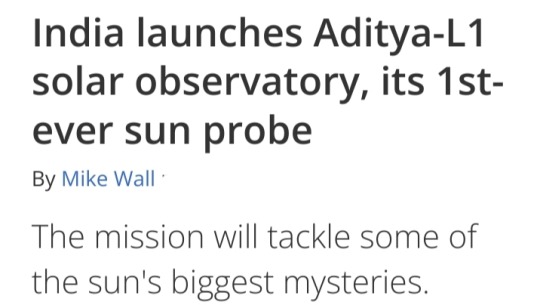
2 September 2022

Fresh off its success at the moon, India is now headed for the sun.
The nation launched its first-ever solar observatory today (Sept. 2), sending the Aditya-L1 probe skyward atop a Polar Satellite Launch Vehicle (PSLV) from Satish Dhawan Space Centre at 2:20 a.m. EDT (0620 GMT; 11:50 a.m. local India time).
The PSLV deployed Aditya-L1 into low Earth orbit (LEO) as planned about 63 minutes after liftoff, sparking applause and high fives in mission control.
"Congratulations, India, and congratulations, ISRO [the Indian Space Research Organisation]," Jitendra Singh, India's Minister of State for Science and Technology, said shortly after deployment on ISRO's launch webcast.
"While the whole world watched this with bated breath, it is indeed a sunshine moment for India," Singh added.
The successful launch followed on the heels of another big milestone for India: On August 23, its Chandrayaan-3 mission became the first to land softly near the moon's south pole.
Chandrayaan-3's lander-rover duo are expected to conk out in a week or so, when the harsh lunar night falls at their touchdown site. But Aditya-L1's long journey has just begun.
A long road to a good sun-viewing spot
Aditya-L1 won't stay in LEO forever:
After a series of checkouts, it will use its onboard propulsion system to head toward Earth-sun Lagrange Point 1 (L1), a gravitationally stable spot about 1 million miles (1.5 million kilometers) from our planet in the direction of the sun.
That destination explains the latter part of the mission's name. And the first part is simple enough: "Aditya" translates to "sun" in Sanskrit.
The 3,260-pound (1,480 kilograms) observatory will arrive at L1 about four months from now, if all goes according to plan.
But the long trek will be worth it, according to the ISRO.
"A satellite placed in the halo orbit around the L1 point has the major advantage of continuously viewing the sun without any occultation/eclipses," ISRO officials wrote in an Aditya-L1 mission description.
"This will provide a greater advantage of observing the solar activities and its effect on space weather in real time."
Indeed, another sun-studying spacecraft is already at L1 — the Solar and Heliospheric Observatory (SOHO), a joint NASA-European Space Agency mission that launched in December 1995.
(Several other spacecraft, including NASA's James Webb Space Telescope, are at Earth-sun Lagrange Point 2, which is a million miles from Earth, in the direction away from the sun.)

Solar flares, the coronal heating mystery and more
Once it's settled in at L1, the solar probe will use four three science instruments to study the particles and magnetic fields in its immediate surroundings and four others to scrutinize the sun's surface (known as the photosphere) and its atmosphere.
This work will help scientists better understand solar activity, including the dynamics of solar flares and coronal mass ejections (CMEs), ISRO officials say.
Flares are powerful flashes of high-energy radiation, and CMEs are huge eruptions of solar plasma.
Both types of outburst can affect us here on Earth. Intense CMEs that hit our planet, for example, trigger geomagnetic storms that can disrupt satellite navigation and power grids.
(As a side benefit, such storms also supercharge the gorgeous light shows known as auroras.)
Aditya-L1 will also tackle the "coronal heating problem," one of the biggest mysteries in heliophysics.
The corona — the sun's wispy outer atmosphere — is incredibly hot, reaching temperatures around 2 million degrees Fahrenheit (1.1 million degrees Celsius), according to NASA.
That's about 200 times hotter than the solar surface, which is "only" 10,000 degrees F (5,500 degrees C) or so.
It's still unclear what is responsible for this startling and counterintuitive discrepancy.
(Why would it be hotter away from the sun's core, where the energy-producing nuclear fusion reactions are occurring?)
Aditya-L1 has other science goals as well. For instance, the mission also aims to more fully flesh out the solar wind, the stream of charged particles flowing constantly from the sun, ISRO officials said.
Aditya-L1 will measure the composition of the solar wind and attempt to determine how it is accelerated.
And Aditya-L1 will do all this work on the cheap:
The mission's price tag is about 3.8 billion rupees, or $46 million US at current exchange rates.
That's in the same ballpark as Chandrayaan-3
India's first successful moon-landing mission costs about 6.15 billion rupees, or $74 million US.
For comparison, NASA's most recent big-ticket sun mission, the record-setting Parker Solar Probe, costs roughly $1.5 billion.
This disparity should not be viewed as an indictment of NASA, however; labor costs are much higher in the United States than in India, among other differences between the two nations' economies.
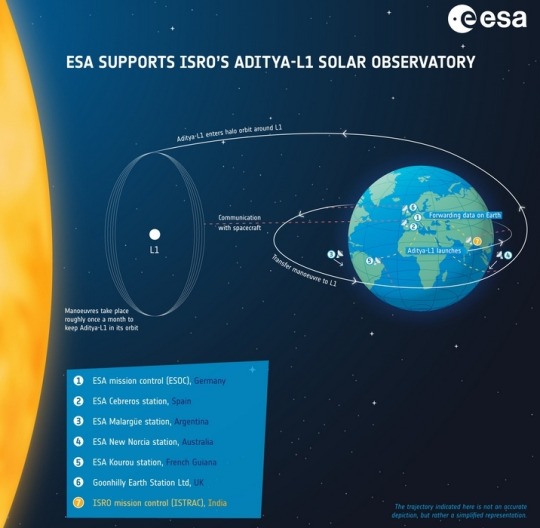
Aditya-L1 is a coronagraphy spacecraft to study the solar atmosphere, designed and developed by the Indian Space Research Organisation (ISRO) and various other Indian research institutes.
#India#Aditya-L1#Polar Satellite Launch Vehicle (PSLV)#Satish Dhawan Space Centre#low Earth orbit (LEO)#sun#Indian Space Research Organisation#Chandrayaan-3#Earth-sun Lagrange Point 1 (L1)#Solar and Heliospheric Observatory (SOHO)#solar flares#coronal mass ejections (CMEs)#coronal heating problem#heliophysics#solar wind#Parker Solar Probe#NASA#solar observatory#solar atmosphere
13 notes
·
View notes
Text
Nagas, the mythical creatures
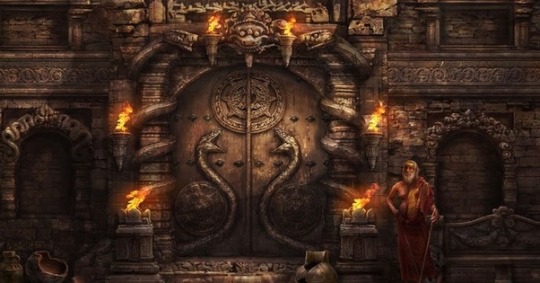
The Nagas
The Nagas, mythical creatures from Hinduism, Buddhism, and Jainism, are half-human and half-cobra beings that can be both a threat and a boon to humans. Their name means 'serpent' in Sanskrit, and they reside in Pata-loka or Naga-loka, an underground kingdom adorned with exquisite jewels and stunning palaces. According to legend, Brahma, their creator, sent them underground when they overpopulated the Earth. They only emerge to bite those who are genuinely evil or fated to die prematurely.
The Nagas were a group of people living during the period of the Mahabharata, an epic from India, and were spread across the country. They had a fierce rivalry with the demigod tribes known as Suparnas. The Naga clans in Kerala and Kashmir were believed to be the original and indigenous abode of all Nagas, and cities like Thiruvananthapuram in Kerala and Anantnag in Kashmir stand as testaments to this. In Hinduism, Jainism, and Buddhism, Nagas can take any shape, but they mostly appear as human beings. They are demigods associated with water and treasure. Lord Shiva, the most powerful god in the Hindu pantheon, wears a garland, anklets, and armlets made of snakes.

Snakes also serve to decorate and protect the gods Bhairav and Mahakala. Ananta, the thousand-headed Naga, protects Kali, the Hindu goddess of destruction. In Hindu myths, Nagas defend the gods and even serve as their resting place. Nagas also safeguard doors, windows, and temple walls, making their carvings and sculptures a common sight in Hindu temples. Female Nagas, referred to as Nagis or Naginis, belong to serpent royalty and are renowned for their breathtaking beauty. They hail from dynasties, including Manipur in northeastern India, Pallavas in southern India, and Indochina's ancient ruling Funan family. The Hindu canon contains several references to beings from other planets.

For example, the Bhagavata Purana, one of the 18 significant Puranas from a Vaishnava perspective, mentions other beings. The creation of the universe is described in detail in Canto 3, the universe in Canto 5, and battles between demigods and demons on other planets are detailed in Canto 8. The Mahabharata also extensively mentions beings on different planets. The Panchang, an ancient Indian calendar, has evolved in Indian astronomy over the past 5000 years. It predicts the exact time of lunar and solar eclipses and the dates and times of all our festivals from time immemorial. It continues to be widely followed in India. The star positions for all significant events in the Mahabharata and Ramayana, two major Indian epics, are also given.
Modern astronomers have dated these positions and found them to be internally consistent. Surprisingly, our ancient story of Dasavatharam, which mentions the ten avatars of Vishnu, also describes the evolution of life from fish to amphibians, animals, half-animal/half-human creatures, short, intelligent humanoids, forest-dwelling axe-men, ideal homo sapiens, wise politicians, and finally, Buddha. Darwin's theory mirrors this up until the homosapien. The tenth avatar, Kalki, is believed to be the technically adept human of tomorrow. Finally, a 16th-century hymn called the Hanuman Chalisa describes the distance to the Sun. It states that one yuga, an epoch, equals 4.32 million years. The Hanuman Chalisa claims that the Sun is at a distance of 100 crore yojanas from the Earth, with one yojana equating to about eight miles, which translates to 800 million miles.
Ancient references mention that the Earth and other planets orbit the Sun and that the size of our solar system is close to the same as it is now. Various texts also discuss the nature of time, reality, and consciousness. Modern science is validating these ideas one by one.
#aliens#history#science#ufology#mytholog#religions#space#news#writers on tumblr#ancient history#conspiracy theories#conspiracies#forbidden knowledge#truth reading
4 notes
·
View notes
Text
Baru fic google searches:
How to use an abacus
How often do lunar eclipses happen
How often do large asteroids hit earth
Kronstadt rebellion
How many armies in Kronstadt rebellion
Is EMDR real
EMDR with no electricity
How big is a Tesla coil
How big was a Sicilian elephant
What was the worst ship wreck in history
What kind of ships did the east india trading company use
How many people can fit on a Fluyt
How hot can iron get before it melts
5 notes
·
View notes